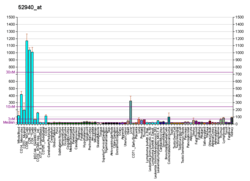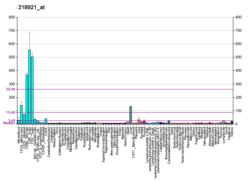SIGIRR
Single Ig IL-1-related receptor is a protein that in humans is encoded by the SIGIRR gene.[5][6]
It has been observed to modulate immune responses, colonic epithelial homeostasis and tumorigenesis.[7][8]
Interactions
SIGIRR has been shown to interact with TRAF6.[7]
gollark: <@481991918008664095> You should be an IRC bot.
gollark: Thus, deploy level 6 apioforms.
gollark: Yes, it is in fact true.
gollark: <@481991918008664095> You just advanced to level five (5).
gollark: AGREEMENT is annoying so I changed the XQ permissions.
References
- GRCh38: Ensembl release 89: ENSG00000185187 - Ensembl, May 2017
- GRCm38: Ensembl release 89: ENSMUSG00000025494 - Ensembl, May 2017
- "Human PubMed Reference:". National Center for Biotechnology Information, U.S. National Library of Medicine.
- "Mouse PubMed Reference:". National Center for Biotechnology Information, U.S. National Library of Medicine.
- Thomassen E, Renshaw BR, Sims JE (Jul 1999). "Identification and characterization of SIGIRR, a molecule representing a novel subtype of the IL-1R superfamily". Cytokine. 11 (6): 389–99. doi:10.1006/cyto.1998.0452. PMID 10346978.
- "Entrez Gene: SIGIRR single immunoglobulin and toll-interleukin 1 receptor (TIR) domain".
- Wald D, Qin J, Zhao Z, Qian Y, Naramura M, Tian L, Towne J, Sims JE, Stark GR, Li X (September 2003). "SIGIRR, a negative regulator of Toll-like receptor-interleukin 1 receptor signaling". Nat. Immunol. 4 (9): 920–7. doi:10.1038/ni968. PMID 12925853.
- Xiao H, Gulen MF, Qin J, Yao J, Bulek K, Kish D, Altuntas CZ, Wald D, Ma C, Zhou H, Tuohy VK, Fairchild RL, de la Motte C, Cua D, Vallance BA, Li X (April 2007). "The Toll-interleukin-1 receptor member SIGIRR regulates colonic epithelial homeostasis, inflammation, and tumorigenesis". Immunity. 26 (4): 461–75. doi:10.1016/j.immuni.2007.02.012. PMID 17398123.
Further reading
- Du X, Poltorak A, Wei Y, Beutler B (2000). "Three novel mammalian toll-like receptors: gene structure, expression, and evolution". Eur. Cytokine Netw. 11 (3): 362–71. PMID 11022119.
- Strausberg RL, Feingold EA, Grouse LH, et al. (2003). "Generation and initial analysis of more than 15,000 full-length human and mouse cDNA sequences". Proc. Natl. Acad. Sci. U.S.A. 99 (26): 16899–903. doi:10.1073/pnas.242603899. PMC 139241. PMID 12477932.
- Clark HF, Gurney AL, Abaya E, et al. (2003). "The secreted protein discovery initiative (SPDI), a large-scale effort to identify novel human secreted and transmembrane proteins: a bioinformatics assessment". Genome Res. 13 (10): 2265–70. doi:10.1101/gr.1293003. PMC 403697. PMID 12975309.
- Ota T, Suzuki Y, Nishikawa T, et al. (2004). "Complete sequencing and characterization of 21,243 full-length human cDNAs". Nat. Genet. 36 (1): 40–5. doi:10.1038/ng1285. PMID 14702039.
- Polentarutti N, Rol GP, Muzio M, et al. (2004). "Unique pattern of expression and inhibition of IL-1 signaling by the IL-1 receptor family member TIR8/SIGIRR". Eur. Cytokine Netw. 14 (4): 211–8. PMID 14715412.
- Gerhard DS, Wagner L, Feingold EA, et al. (2004). "The status, quality, and expansion of the NIH full-length cDNA project: the Mammalian Gene Collection (MGC)". Genome Res. 14 (10B): 2121–7. doi:10.1101/gr.2596504. PMC 528928. PMID 15489334.
- Qin J, Qian Y, Yao J, et al. (2005). "SIGIRR inhibits interleukin-1 receptor- and toll-like receptor 4-mediated signaling through different mechanisms". J. Biol. Chem. 280 (26): 25233–41. doi:10.1074/jbc.M501363200. PMID 15866876.
This article is issued from Wikipedia. The text is licensed under Creative Commons - Attribution - Sharealike. Additional terms may apply for the media files.





